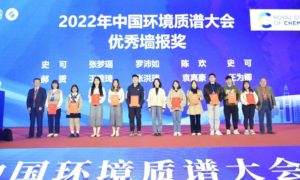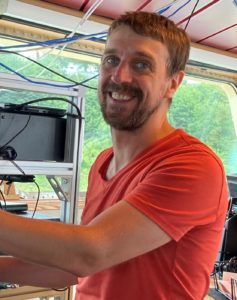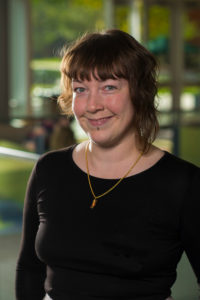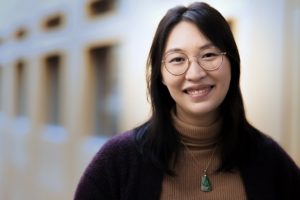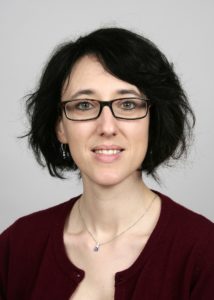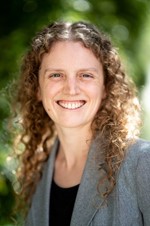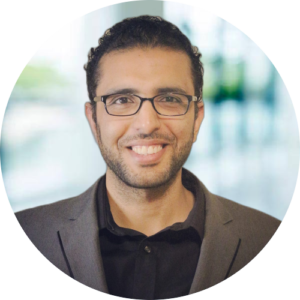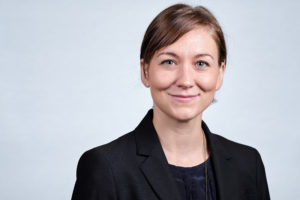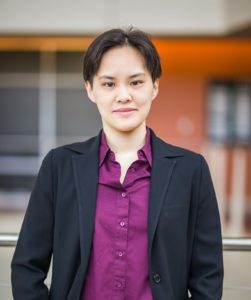 Theo is an Assistant Professor in the School of Energy and Environment at City University of Hong Kong. Her current research uses a combination of laboratory experiments and field observations to investigate the impacts of air pollution policies and climate change on the multiphase atmospheric chemistry of aqueous droplets and the formation and transformation processes of organic aerosols. Theo completed her undergraduate studies in Chemistry and Mathematics at the University of Toronto. She went on to complete Ph.D. studies in Physical Chemistry under the supervision of Prof. Stephen Leone and Dr. Kevin Wilson at the University of California, Berkeley. Her Ph.D. research focused on investigating fundamental reaction mechanisms that govern the heterogeneous photooxidation of organic aerosols. She then went on to complete postdoctoral studies at Georgia Institute of Technology under the supervision of Prof. Sally Ng and Prof. Rodney Weber. There, she performed laboratory chamber studies to investigate biogenic secondary organic aerosol formation mechanisms and participated in field studies to investigate the effect of ammonia on aerosol composition and acidity.
Theo is an Assistant Professor in the School of Energy and Environment at City University of Hong Kong. Her current research uses a combination of laboratory experiments and field observations to investigate the impacts of air pollution policies and climate change on the multiphase atmospheric chemistry of aqueous droplets and the formation and transformation processes of organic aerosols. Theo completed her undergraduate studies in Chemistry and Mathematics at the University of Toronto. She went on to complete Ph.D. studies in Physical Chemistry under the supervision of Prof. Stephen Leone and Dr. Kevin Wilson at the University of California, Berkeley. Her Ph.D. research focused on investigating fundamental reaction mechanisms that govern the heterogeneous photooxidation of organic aerosols. She then went on to complete postdoctoral studies at Georgia Institute of Technology under the supervision of Prof. Sally Ng and Prof. Rodney Weber. There, she performed laboratory chamber studies to investigate biogenic secondary organic aerosol formation mechanisms and participated in field studies to investigate the effect of ammonia on aerosol composition and acidity.
Read Theodora’s Emerging Investigator Series article “Aqueous photooxidation of live bacteria with hydroxyl radicals under clouds-like conditions: Insights into the production and transformation of biological and organic matter originating from bioaerosols” and read more about her in the interview below:
Your recent Emerging Investigator Series paper focuses on Aqueous photooxidation of live bacteria with hydroxyl radicals under clouds-like conditions: Insights into the production and transformation of biological and organic matter originating from bioaerosols. How has your research evolved from your first article to this most recent article?
My Ph.D. studies focused on the heterogeneous photooxidation of organic aerosols. My first lead-author publication (Nah et al., Anal. Chem. 2013) was on the application of Direct Analysis in Real Time Mass Spectrometry (DART-MS) in the real-time in situ chemical characterization of submicron organic aerosols. It demonstrated how we can use surface sensitive mass spectrometric tools to probe real-time changes in the chemical composition of the surface of submicron organic aerosols during heterogenous photooxidation. I have continued my research on atmospheric aerosol chemistry. However, my research interests have expanded even further to include the atmospheric chemistry of bioaerosols under different environmental conditions. In this most recent article, my group investigated what happens when live bacteria interact with hydroxyl radicals in clouds during the daytime. It builds on our previous work (Liu et al., Atm. Chem. Phys. 2023) which investigated the effects of pH and light exposure on the survival of bacteria and their ability to biodegrade organic compounds in clouds.
What aspect of your work are you most excited about at the moment?
I have found this research area (i.e., atmospheric chemistry of bioaerosols) to be both exciting and challenging because I do not have a background in microbiology. In fact, I have not taken a single biology class in my entire life! I spent a lot of time during the COVID-19 lockdown learning about bacteria. I am lucky that I was able to establish a research collaboration with a microbiologist in my department who is interested in atmospheric bioaerosols. Our ongoing research collaboration has been fruitful and we have been able to leverage one another’s expertise to ask and answer interesting research questions on bioaerosols. In addition to investigating the atmospheric chemistry of bioaerosols in outdoor atmospheres, we have been investigating what happens when airborne bioaerosols and microorganisms adhered on surfaces interact with atmospheric oxidants and chemical compounds in the indoor built environment. Stay tuned for more of our work!
In your opinion, what are the most important questions to be asked/answered in this field of research?
At present, little is known about what happens when live microorganisms such as bacteria interact with atmospheric oxidants and chemical compounds in the outdoor and indoor atmospheres under different environmental conditions. These multiphasic interactions potentially have important implications for atmospheric processes, air quality, and human health. There are so many questions that still need to be asked and answered in order for us to gain a basic understanding of these interactions before we can even consider their implications. Asking and answering these questions will require the expertise of both atmospheric chemists and microbiologists.
What do you find most challenging about your research?
Communicating my research to people with different backgrounds and levels of expertise. A lot of my research use laboratory experiments to investigate fundamental reaction mechanisms and understand how things work at the molecular level. Sometimes, I find it challenging to convince others, especially those not in the atmospheric chemistry field, on the importance and relevance of my research approach to solve “real world” air pollution issues.
In which upcoming conferences or events may our readers meet you?
I will be presenting my work at the 9th International Conference on Fog, Fog Collection, and Dew in Colorado in late July, and at the 2023 Atmospheric Chemistry Gordon Research Conference in Maine in early August.
How do you spend your spare time?
I spend most of my spare time watching travel documentaries to unwind. Recently, I have been spending some of my spare time learning Mandarin so that I can communicate more effectively with my Chinese collaborators.
Which profession would you choose if you were not a scientist?
If I were not a scientist, I would still want do something related to the environment. I could see myself working for an NGO involved in environment management and conservation work.
Can you share one piece of career-related advice or wisdom with other early career scientists?
I have been fortunate to have encountered many amazing mentors who have been generous with their time and advice. I will share the same piece of advice that one of my mentors gave me when I was deciding on where to attend graduate school: You need to embrace change and be willing to step outside of your comfort zone. I find that this piece of advice can be applied to career development, research, and so on. I have relied on this advice at various points of my career, including when I decided to move to a new country to start my independent research career, and when I pursued opportunities for multi-disciplinary collaborations to work on interesting research questions.











